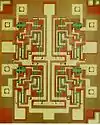10 µm process
The 10 μm process (10 micron smallest dimension) is the level of MOSFET semiconductor process technology that was commercially reached around 1971,[1][2] by leading semiconductor companies such as RCA and Intel.
| Semiconductor device fabrication |
|---|
 |
|
MOSFET scaling (process nodes) |
|
Future
|
Products featuring 10 μm manufacturing process
- RCA's CD4000 series of integrated circuits began with a 20 μm process in 1968, before gradually downscaling and eventually reaching 10 μm in the next several years.[3]
- Intel 1103, an early dynamic random-access memory (DRAM) chip launched in 1970, used an 8 μm process.[4]
- Intel 4004 CPU launched in 1971 was manufactured using a 10 μm process.[5]
- Intel 8008 CPU launched in 1972 was manufactured using this process.[5]
References
- Mueller, S (21 July 2006). "Microprocessors from 1971 to the Present". informIT. Retrieved 11 May 2012.
- Myslewski, R (15 November 2011). "Happy 40th birthday, Intel 4004!". TheRegister. Archived from the original on 19 April 2015. Retrieved 19 April 2015.
- Lojek, Bo (2007). History of Semiconductor Engineering. Springer Science & Business Media. p. 330. ISBN 9783540342588.
- Lojek, Bo (2007). History of Semiconductor Engineering. Springer Science & Business Media. pp. 362–363. ISBN 9783540342588.
The i1103 was manufactured on a 6-mask silicon-gate P-MOS process with 8 μm minimum features. The resulting product had a 2,400 μm, 2 memory cell size, a die size just under 10 mm2, and sold for around $21.
- "History of the Intel Microprocessor - Listoid". Archived from the original on 27 April 2015. Retrieved 19 April 2015.
External links
| Preceded by 20 μm process |
MOSFET semiconductor device fabrication process | Succeeded by 6 μm process |
This article is issued from Wikipedia. The text is licensed under Creative Commons - Attribution - Sharealike. Additional terms may apply for the media files.